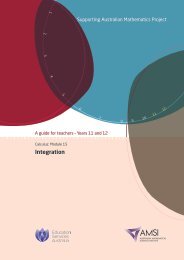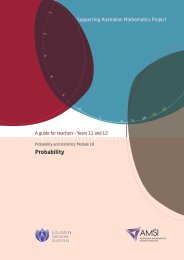Quadratics - the Australian Mathematical Sciences Institute
Quadratics - the Australian Mathematical Sciences Institute
Quadratics - the Australian Mathematical Sciences Institute
You also want an ePaper? Increase the reach of your titles
YUMPU automatically turns print PDFs into web optimized ePapers that Google loves.
{42} • <strong>Quadratics</strong><br />
Exercise 16<br />
The equations of <strong>the</strong> normals at P and Q are respectively<br />
x + py = 2ap + ap 3 and x + q y = 2aq + aq 3 .<br />
Subtracting we have<br />
y(p − q) = a(p 3 − q 3 ) + 2a(p − q) = a(p − q)(p 2 + q 2 + pq + 2)<br />
so y = a(p 2 + q 2 + pq + 2). Substituting back we have x = −apq(p + q) after simplifying.<br />
Hence R is <strong>the</strong> point ( −apq(p + q), a(p 2 + q 2 + pq + 2) ) .<br />
Now, if PQ is a focal chord, <strong>the</strong>n pq = −1. Thus <strong>the</strong> x- and y-coordinates of R become<br />
x = a(p +q) and y = a(p 2 +q 2 +1) = a ( (p +q) 2 +3 ) , since pq = −1. We can <strong>the</strong>n eliminate<br />
p and q to obtain<br />
( ( x<br />
) ) 2<br />
y = a + 3 = x2<br />
a a + 3a,<br />
which is a parabola.<br />
Exercise 17<br />
Squaring<br />
√<br />
√<br />
(x − c) 2 + y 2 = 2a − (x + c) 2 + y 2 ,<br />
we have<br />
√<br />
a (x + c) 2 + y 2 = a 2 + xc.<br />
Squaring again and rearranging, we arrive at<br />
x 2 (a 2 − c 2 ) + a 2 y 2 = a 2 (a 2 − c 2 ).<br />
Dividing by a 2 (a 2 − c 2 ) gives <strong>the</strong> desired equation.
















